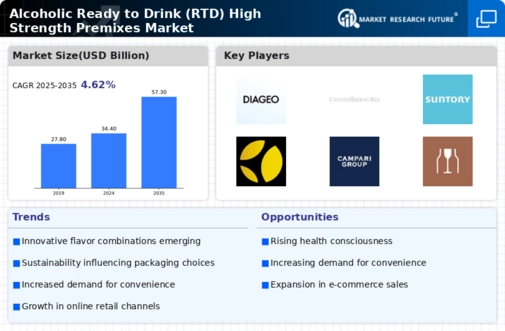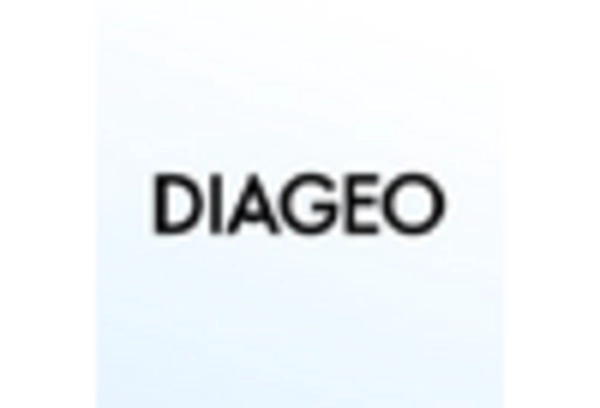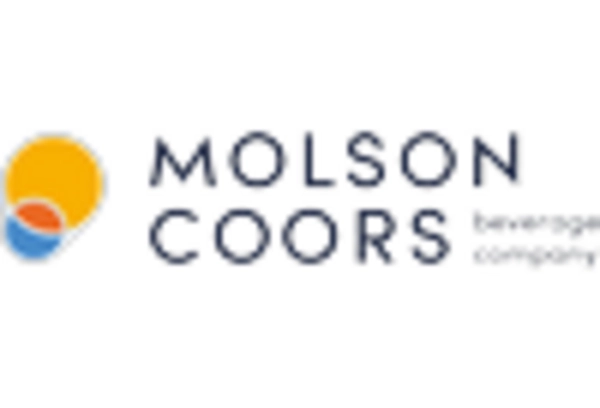Health and Wellness Trends
The Alcoholic Ready to Drink (RTD) High Strength Premixes Market is increasingly influenced by health and wellness trends. Consumers are becoming more health-conscious, seeking products that align with their lifestyle choices. This has led to a rise in demand for lower-calorie, organic, and natural ingredient options within the RTD segment. Market data indicates that products marketed as healthier alternatives are gaining traction, with sales growth in this category outpacing traditional offerings. As brands respond to this demand by reformulating their products, the Alcoholic Ready to Drink (RTD) High Strength Premixes Market is likely to see a diversification of offerings that cater to health-oriented consumers, potentially reshaping the competitive landscape.
Evolving Consumer Preferences
The Alcoholic Ready to Drink (RTD) High Strength Premixes Market is witnessing a shift in consumer preferences towards convenience and flavor variety. As lifestyles become increasingly fast-paced, consumers are gravitating towards ready-to-drink options that offer both portability and a diverse range of flavors. This trend is underscored by data indicating that the RTD segment has experienced a notable increase in sales, with a projected growth rate of approximately 8% annually. The demand for innovative flavor combinations and premium ingredients is driving brands to expand their product lines, catering to a more adventurous consumer base. This evolution in preferences suggests that the Alcoholic Ready to Drink (RTD) High Strength Premixes Market is adapting to meet the desires of a modern audience, potentially leading to increased market penetration and brand loyalty.
Innovative Marketing Strategies
The Alcoholic Ready to Drink (RTD) High Strength Premixes Market is experiencing a transformation driven by innovative marketing strategies. Brands are leveraging digital marketing, influencer partnerships, and experiential campaigns to engage consumers more effectively. This approach not only enhances brand visibility but also fosters a deeper connection with target audiences. Market analysis indicates that companies employing these strategies have seen a significant uptick in sales, with some reporting increases of over 15% in specific demographics. By creating compelling narratives around their products, brands are able to differentiate themselves in a crowded marketplace. This trend suggests that the Alcoholic Ready to Drink (RTD) High Strength Premixes Market is evolving, with a focus on creating memorable consumer experiences that resonate with modern values.
Rise of Social Drinking Culture
The Alcoholic Ready to Drink (RTD) High Strength Premixes Market is significantly influenced by the rise of social drinking culture, particularly among younger demographics. Social media platforms have amplified the visibility of RTD products, encouraging consumers to share their experiences and preferences. This trend is reflected in market data, which shows that RTD beverages are increasingly favored for social gatherings and events, contributing to a surge in demand. The convenience of these products aligns well with the lifestyle of younger consumers who prioritize ease of consumption without compromising on taste. As social interactions continue to evolve, the Alcoholic Ready to Drink (RTD) High Strength Premixes Market is likely to benefit from this cultural shift, fostering a community around shared drinking experiences.
Sustainability and Ethical Consumption
The Alcoholic Ready to Drink (RTD) High Strength Premixes Market is increasingly shaped by consumer demand for sustainability and ethical consumption. As awareness of environmental issues grows, consumers are favoring brands that demonstrate a commitment to sustainable practices, such as eco-friendly packaging and responsible sourcing of ingredients. This trend is reflected in market data, which shows that products with sustainable credentials are experiencing higher sales growth compared to conventional options. Brands that prioritize sustainability not only enhance their appeal but also build trust with consumers. As this movement gains momentum, the Alcoholic Ready to Drink (RTD) High Strength Premixes Market is likely to evolve, with sustainability becoming a key differentiator in product offerings.


















Leave a Comment